Visiting Munich in winter? Here is everything you need to know, from amazing things to do, what to wear, where to eat, and more!
Snow-covered castles. Festive Christmas markets. Lively beer halls. Hearty Bavarian food. There are so many wonderful Munich winter activities, and so much to love about the city!
When I was figuring out what cities to visit on a winter European getaway, I immediately put Munich on my list along with Prague because of the close proximity to the fairytale Neuschwanstein Castle, and because it is home to some of the best Christmas markets in Europe.
Aside from that, there were lots of things to do in winter in Munich, with plenty of beautiful museums and churches to to escape the cold (here’s the perfect Munich itinerary that has some of the top sights).
It definitely did not disappoint. Yes, it was cold , but December in Munich was absolutely magical and the city came alive with the festive spirit in the air. And there is nothing quite like visiting an authentic German Christmas market, and the ones in Munich are among the best!
Besides, the cold was nothing that some German beer couldn’t cure – and there were plenty of beer halls and beer gardens around the city!
Here is everything you need to know about Munich in winter!
Disclosure: This post contains affiliate links. This means that if you make a purchase or booking, I may receive a small commission at no additional cost to you. Pictures & Words is a participant in the Amazon Services LLC Associates Program, an affiliate advertising program designed to provide a means for us to earn fees by linking to amazon.com and affiliated sites at no cost to you.


Winter Weather in Munich and What to Pack
There’s no getting around it – winter in Munich is COLD. While winter weather in Munich is milder and warmer than in the northern parts of Germany, temperatures hover near freezing and rain and snow are common – I experienced both during my time in Munich.
Average temperatures are as follows:
- December in Munich: High 39°F (4° C) / Low 29° (-2° C)
- January in Munich: High 38°F (3° C) / Low 27° (-3° C)
- February in Munich: High 40°F (4° C) / Low 28° (-3° C)
Because I’d never really traveled in the winter to anywhere that actually experiences winter weather (mostly because I was scared of it), I felt overwhelmed when I was starting to figure out what to pack.
Yes, it is pretty cold, so obviously you will need warm winter clothing. However, apparently Germans like to turn up their heat very high, so I found myself to be very, VERY warm whenever I was inside a museum, restaurant, or cafe.
The key here is to pack lots of layers – bonus points if you can get them on and off quickly!
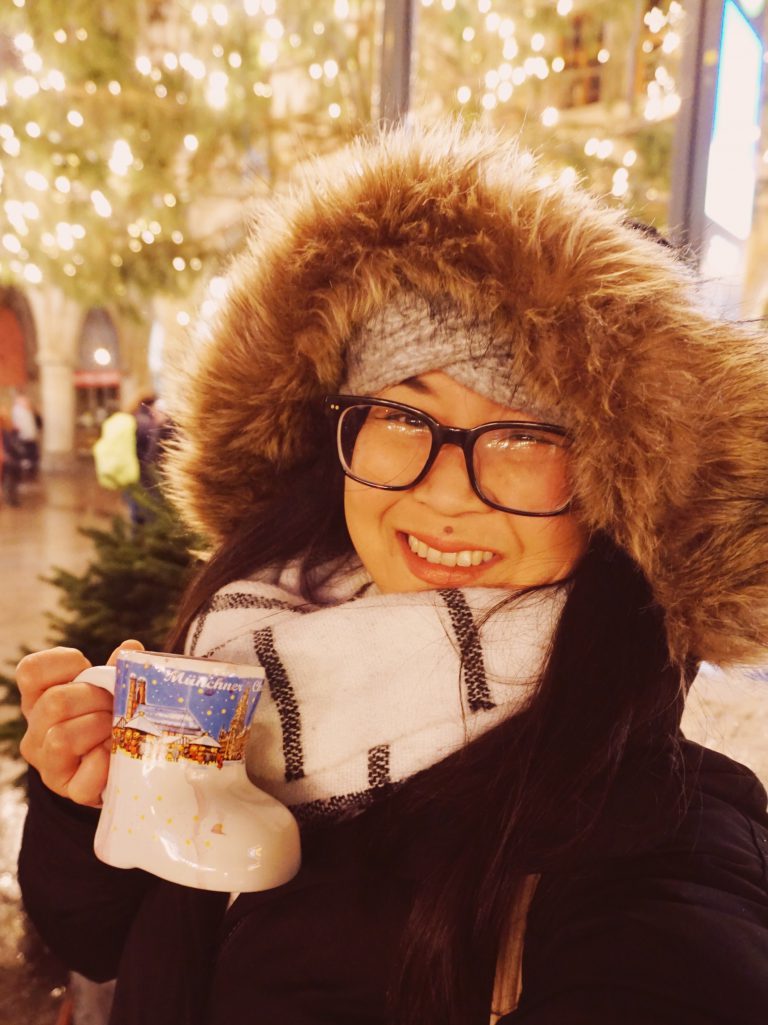

Here are some suggested items to pack for Munich in winter:
- Warm winter coat: I packed a waterproof winter jacket like similar to this winter jacket, but if you want to be extra classy, a wool trench coat also works.
- Warm, waterproof, and comfortable boots: I packed my favorite winter boots (they’ve been discontinued but these are also similar boots) as my only pair of shoes for a week of winter weather in Europe, and they were perfect, even as I was walking over 30,000 steps a day! They kept my feet warm, and dry even though I encountered rain and snow.
- Sweaters: To add extra warmth on those chilly days/nights. A sweater dress is super cute and keeps you warm as well!
- Flannel button-down: Makes a perfect layering piece for winter in Munich.
- Cardigans: Also a perfect layering piece, especially because you can get them on and off easily.
- Fleece-lined leggings: Perfect under your sweater dresses, or as an extra layer of warmth under your jeans.
- Lightweight thermals: I’ve been wearing the Uniqlo Heattech shirts for years and they definitely came in handy during my time in Munich! I love that they are lightweight but keep you warm without making you sweaty and moist.
- Beanie: I also packed a knitted headband to switch it up a bit.
- Warm Gloves: These gloves also allow you to use your touchscreen smartphone without taking them off.
- Wool Socks: These wool socks will keep your feet nice and toasty (and will wick moisture)!
- Scarves: I packed a thick infinity scarf, as well as a blanket scarf (this is my favorite scarf!)
- Power Adapter: If coming from outside of Europe.
- Power Bank: To keep your devices charged – the cold makes your phone battery drain fast! I never travel without this one – one charge will give five full charges to your devices.
Fun Things to Do in Munich in Winter

Visit the Christmas markets around town
One of the things I was looking forward to most about visiting Munich in winter was being able to visit all of the Christmas markets around the city, and they did not disappoint! Munich is known as having some of the best Bavarian Christmas Markets, and seeing all these festive markets pop all up all around the city really made it so much fun.
The great thing about the Christmas markets in Munich is that many of them are held at some of the city’s top attractions, so you’ll get to sip on some gluhwein (quite possibly one of the best Munich winter activities) and snack on some candied almonds while crossing things off your Munich itinerary.
If you’ve never been to a European Christmas market, then you are definitely in for a treat. I’ve visited so-called Christmas markets in the States, and never really saw why they were such a thing, but the Europeans go all out and it is a completely different experience! It’s definitely one of the best things about visiting Munich in the winter.
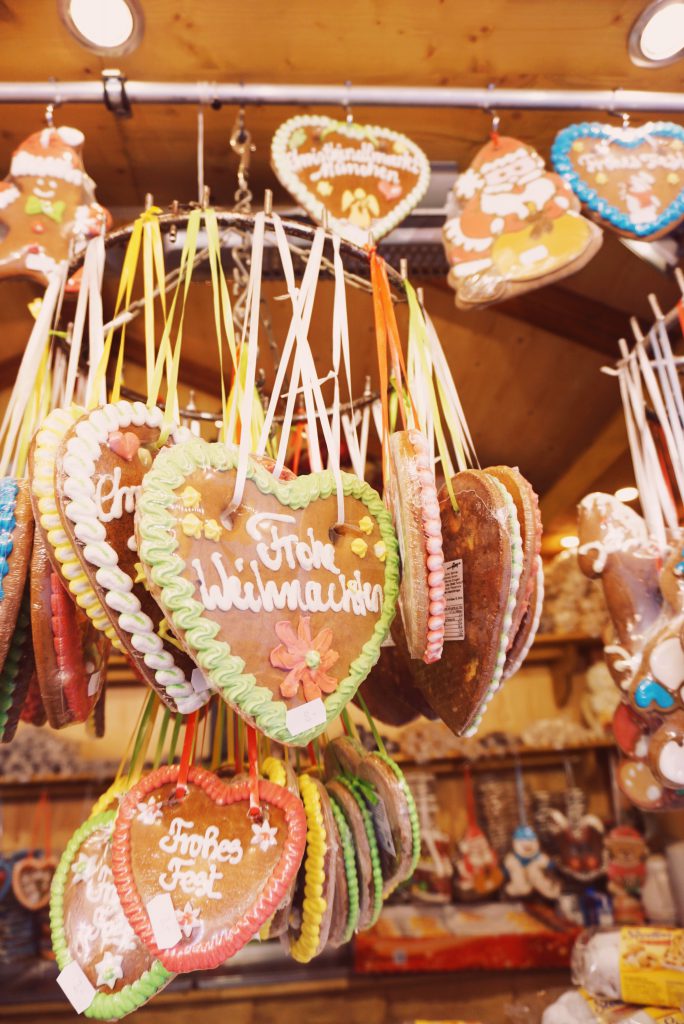

You’ll find plenty of food stalls serving traditional German specialties and sweets, and lots of handcrafted Bavarian handicrafts and holiday items – I found some handcrafted Christmas ornaments that made perfect souvenirs!


Be sure to sip on some gluhwein (mulled wine), served in a super cute commemorative mug. Each market has its own unique mug, so have fun going around to all the different ones and collecting all the different ones – they make the perfect souvenirs!
Other things to try at the Chrismtas Markets include bratwurst, curry wurst, Gebrannte Mandeln (roasted almonds), and Käsespätzle (kinda like German mac and cheese).
Munich is well-known to have some of the best Christmas markets in Europe, so visiting at least one (preferably multiple) of them is a must!There’s a market for everyone – you’ll find everything from your traditional European Christmas market, to more offbeat ones.


Want to visit some of the best Christmas markets in the city, as well as sample the best food at each one? I suggest taking this Christmas Market tour!
Opening dates vary by market; most run from the end of November until the days leading up to Christmas, but a few run into January as well.
Here are the best Christmas markets you need to check out:


Marienplatz (2024 dates: November 25-December 24): This is the main market in the city, held right in the heart of the Marienplatz square. It’s also one of Europe’s oldest Christmas Markets, dating back to the 14th century. You’ll find tons of stalls set up in the middle of the square, and it has such a magical setting. Be sure to pick up some gluhwein here – it comes in such a cute boot-shaped mug! Do note that it’s super popular, so be ready for crowds.
Sternenplatzl At Rindermarkt: This one neighbors Marienplatz but is a bit less crowded with a more open feel. There’s tons of tinkling lights hanging overhead, which gives it a magical feel.


Christmas Village at Munich Residenz (2024 dates: November 18-December 22): A Christmas Market set up in the courtyard of a royal palace? Ummm…yes please! This one was one of my favorites because they made it feel like a little mini-village and has a cozy, festive vibe.
Christkindlmarkt at Sendlinger Tor (gate): This Christmas Market takes place at the old gates of the city, and dates back to 1886. It’s got a bit of a multi-cultural feel, with international goods and nativity scenes from Tyrol and Peru.
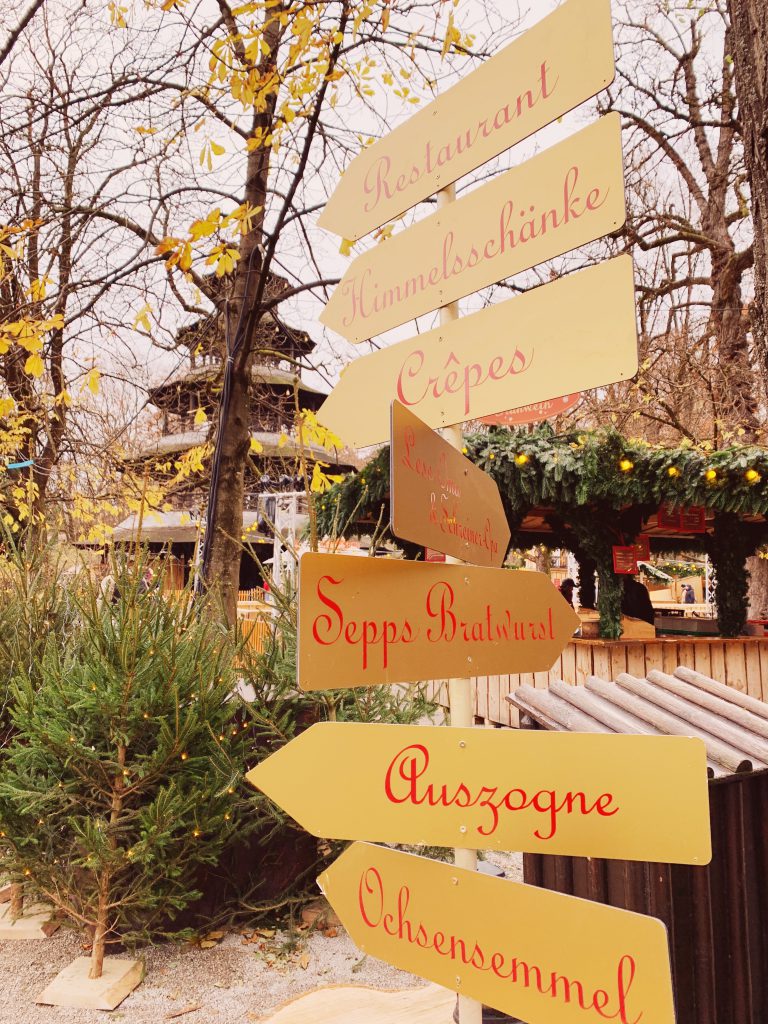

Christmas Market at the Chinesischer Turm (2024 dates: November 27-December 23): This market is located near the Chinese Tower inside the sprawling English Garden, and has sort of a woodsy feel. The park is gorgeous, and there’s a romantic vibe here – you can even ride in a horse-drawn carriage.
Winter Magic at the Viktualienmarkt (2024 Dates: November 27-December 24): This Christmas Market is perfect for foodies! Taking place at the Viktualienmarkt food marketplace, you’ll find tons of gourmet foods and local food specialties that make perfect souvenirs.
Märchenbazar (The Fairytale Bazaar) (2024 dates: November 28-December 29): I ended up stumbling into this market because it was located very close to my hotel. It’s got a unique circus setting, with tons of twinkly lights and a big top.
Munich Advent Spectacle and Medieval Christmas Market (2024 dates: November 25-December 23): This is one of the city’s most unique Christmas Markets, with a medieval theme! You’ll find vendors selling ancinent handicrafts dressed in period costumes, gluhwein served in clay goblets, and Medieval cuisine.
Pink Christmas (2024 Dates: November 25-December 23): Another one of Munich’s unique Christmas Markets, catered to the LGBTQ crowd. It’s one of the most inclusive markets, and everything here is pink!
Want to learn more about the Munich Christmas Markets? Read my guide to the best Christmas Markets in Munich to find out where to go, along with tips on what to eat + buy!
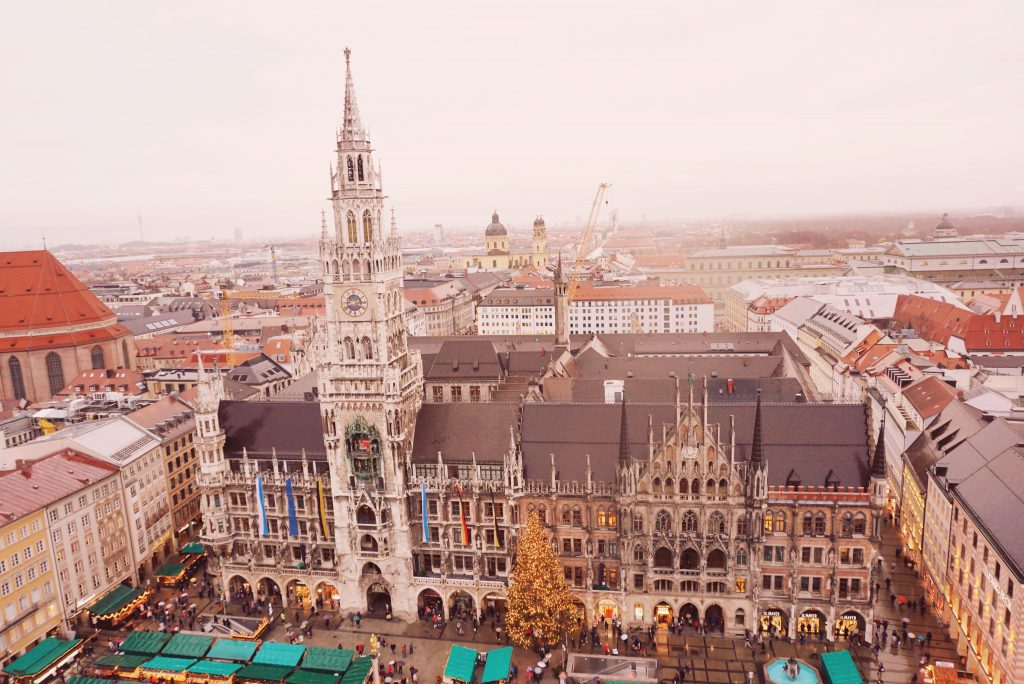
Hang out in Marienplatz, the heart of the city
The beautiful Marienplatz square has been Munich’s central gathering place since the 12th century, and is quite possibly the city’s number one tourist attraction.


You’ll find far fewer crowds at Marienplatz when visiting in winter than visiting in the summer. Even if you do come to the Christmas market here (which I think is a must, if you visit Munich during Christmas!), I still think it’s worth making a separate visit while the stalls are closed to truly appreciate the beauty of the Marienplatz, without the flurry of activity.

Admire the stunning Gothic architectural details of the Neues Rathaus (New Town Hall). Be sure to also check out the beautiful courtyard as well. On the other side of the square stands the whimsical Altes Rathaus (Old Town Hall), which houses a toy museum today.
In the center of the square you will find the Mariensäule column, atop which a golden statue of the Virgin Mary watches over the city of Munich and the state of Bavaria. The Mariensäule also symbolizes the center of the city, and is used as a starting point for signposts from other locations to the city.
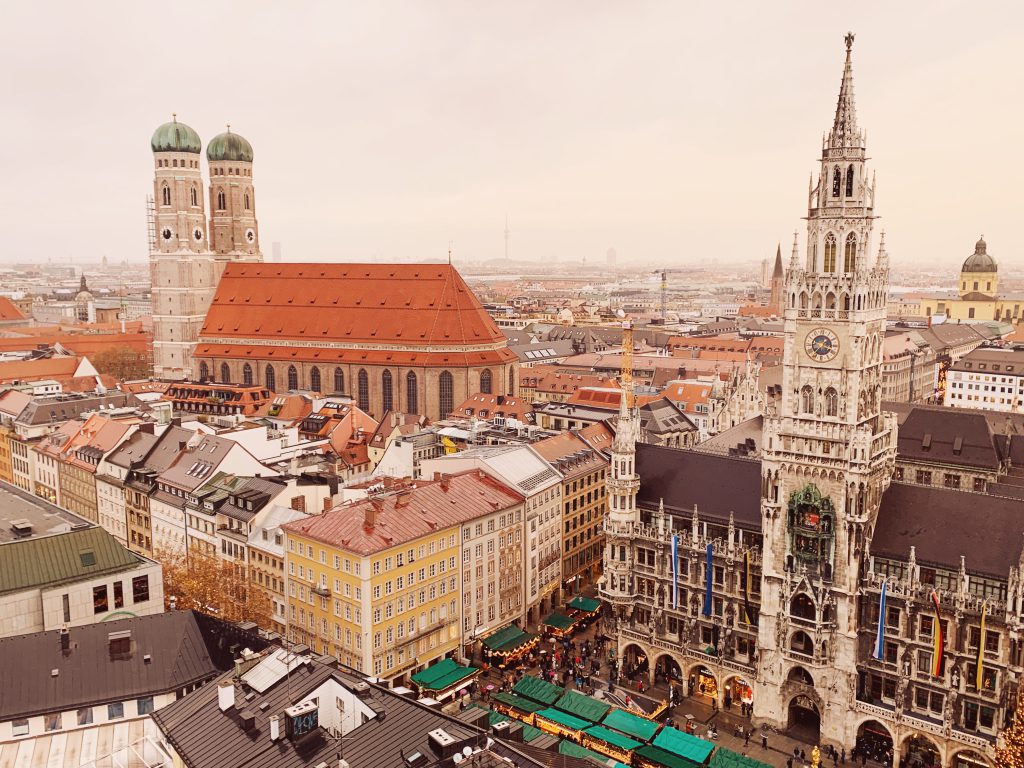
Check out the view from the top of the Peterskirche church tower
For an epic view of Marienplatz and the Munich skyline, head up the tower of the Peterskirche (St. Peter’s Church) tower.
You’ll have to climb roughly 300 wooden steps to get there (and it gets congested – the whole experience kind of reminded me of going up to the top of the Duomo in Florence) – but trust me, the view is absolutely worth it!
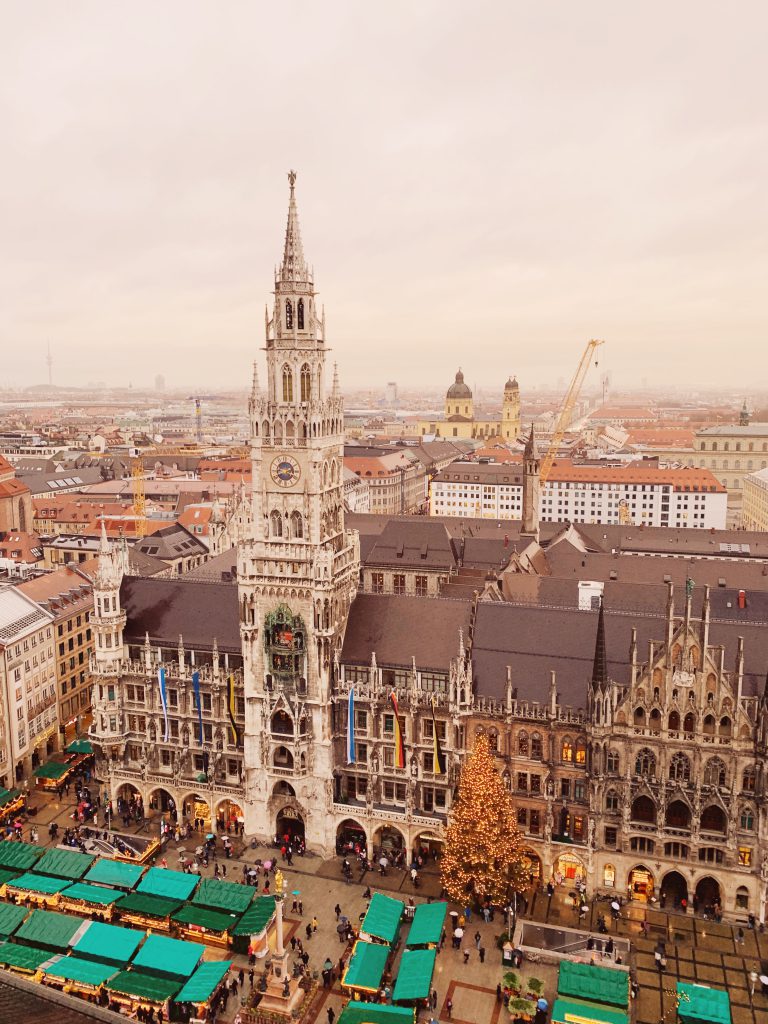

From the top, you’ll get a panoramic view of Munich’s beautiful city center laid out in front of you, and the climb will have been worth it. Take a moment to admire all the architectural details of the Neues Rathaus and Altes Rathaus, and gaze at all the lovely orange rooftops in the city.
The view is especially gorgeous during this season – if you come around the holidays, you’ll see the twinkly Christmas lights…and if you’re lucky enough to be in town when it snows, then you’ll see those orange rooftops with a dusting of snow. Absolutely magical!
It costs €2 to go up to the top of the tower, and save a few Euro coins, because only cash is accepted.

Visit one of Munich’s beautiful churches
Munich is home to some of Germany’s most beautiful churches. Taking a peek into at least a few of these churches is one of the best Munich winter activities – you’ll get to escape the cold, as well as experience the city’s history and architectural beauty.
Aside from Peterskirche, here are some of the churches you should check out:


- Frauenkirche: The towering twin domes of the Frauenkirche dominate the Munich skyline and are one of the most distinctive icons in Munich. The best view of the domes is actually from Peterskirche, but it is still worth taking a peek inside one of the most iconic churches in Munich. The church dates back to 1488 and isn’t as ornate as some of the others in the city, but has a rather odd “Devil’s Footprint” that makes it worth a visit.
- Asamkirche: This stunner is a shining example of Baroque architecture and is quite possibly the most opulent church in Munich. Built by two artist brothers in the 1700, the Asamkirche was originally meant to be a private church, but permission was only granted to build it after the brothers promised access for all. The impressive interior is covered in gold leaf, stained glass and carved cherubs, with richly painted ceilings.
- Theatinerkirche: I was initially drawn to the pastel yellow facade of the Theatinerkirche, which sits near Odeonsplatz, right across from the Residenz palace. The Theatinerkirche dates back to the 1600s, and is one of the oldest churches in Munich. The interior is all white, with incredible details, with a huge Baroque dome. It also houses a crypt where many members of the Bavarian royal family were buried.

Sample all the gourmet goodies at Viktualienmarkt
Wandering through all the stalls of Viktualienmarkt, the city’s open-air food market, is a must! Foodies will obviously love this place, but even if you don’t consider yourself to be one, there’s still something for everyone to love.
Located in the heart of Munich’s old town, Viktualienmarkt started as a farmer’s market, but has grown into so much more over the years.
You’ll find a plethora of fresh produce, delicious bites to snack on, colorful flowers, exotic spices, cheese, local German wine, and much more (it kinda reminded me of the Boqueria in Barcelona, in a way).
An awesome way to experience the best of what the market has to offer and learn more about its history and significance during a food tour with a local guide.
It’s even got a beer garden – and if your winter in Munich trip lands around the holidays, there’s also a Christmas market set up here, so you’ll find lots of gluhwein too!
It’s also the best place to shop for local goods to take home as souvenirs. I loved the beautiful decorations that were made out of dried cinnamon and cloves, and the wooden ornaments.
Also look for the authentic Bavarian Maibaum (maypole) in the middle of the market. Maibaums are a common sight in Bavaria, and date back to ancient times. They represent a village or borough and its trade.
The figures that are on the Maibaum at Viktualienmarkt represent various aspects of life in Munich, including a horse and cart transporting barrels of beer, scenes from Oktoberfest, the flag of Munich, and the two patron saints of brewing, St. Boniface and St. Florian.

Pretend you’re a royal at the Munich Residenz
The stunning Munich Residenz was the home of Bavarian monarchs, and served as the seat of the government from 1508-1918. The massive complex includes multiple buildings and 10 courtyards, making it the largest city palace in all of Germany.
While the Residenz may not look like much just by looking at the outside, the inside is absolutely stunning. You can literally spend all day here, but even if you only have a few hours, it is well worth a visit (it is the perfect place to escape the cold).


As you walk through the Residenz’s 150 rooms, each gets more opulent and extravagant, filled with gold-plated details, magnificent sculptures, stunning chandeliers, majestic paintings, tapestries, and more.
The absolute highlight of the Residenz is the Antiquarium, a long hall with vaulted ceilings covered with incredible Renaissance-era frescos. The Antiquarium was built to store the extensive antique collection of the Wittelbach family, who lived in the palace for over 400 years.


I had seen photos of the Antiquarium on Instagram, which convinced me that I had to visit the Residenz – and it absolutely did not disappoint. I stood in the room for a long time, absolutely in awe (and snapping lots of photos!).
Also of note at the Residenz is the Treasury, which houses a collection of jewels spanning over 1000 years, and is one of the most important in the world. You’ll find plenty of treasures, from the royal insignia, jewel-encrusted swords, Chinese porcelain, Turkish daggers, and Crown of Princess Blanche, which dates back to 1370 and is the oldest surviving royal crown known to have been in England.
If you visit in December, be sure to check out the Christmas market held in the main courtyard!
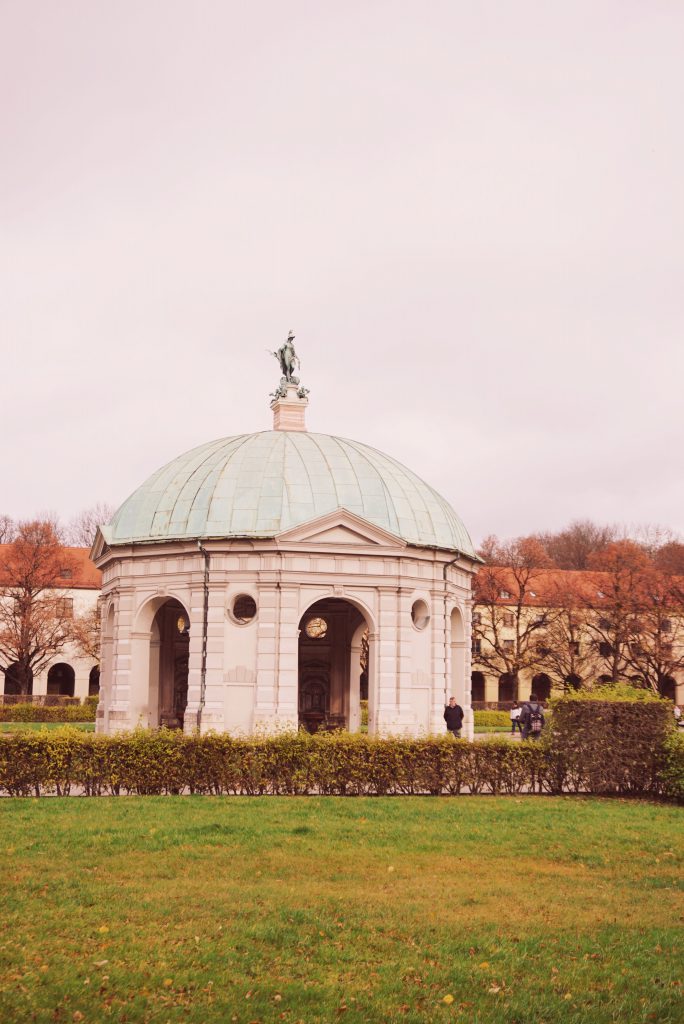

Stroll through the idyllic Hofgarten, the royal garden
Just behind the Residenz is the Hofgarten, a beautiful green space that is a favorite of both visitors and locals. The Hofgarten was built as part of the royal palace in the early 17th century by Elector Maximilian I. In 1780, the gardens were opened to the public by Elector Karl Theodor.
The Hofgarten is designed in the Italian Renaissance style, and features beautiful arcade-style passages, fountains, and more. Even though nothing was really in bloom because it was winter, the gardens were absolutely beautiful and well worth a stroll through.


At the center is the Dianatempel Pavilion, a stunning twelve-sided gazebo with eight entrance archways. The Dianatempel has been used as a filming site for several movies, including the Three Musketeers, and you’ll often find classical musicians playing inside of it (alas, there was not when I was there).
The other highlight of the Hofgarten is the Bavarian State Chancellery building (Bayerische Staatskanzlei), which stands on the east side of the garden. You cannot miss it – the impressive building has a striking stone dome and glass wings, and is the center of Bavaria’s power.
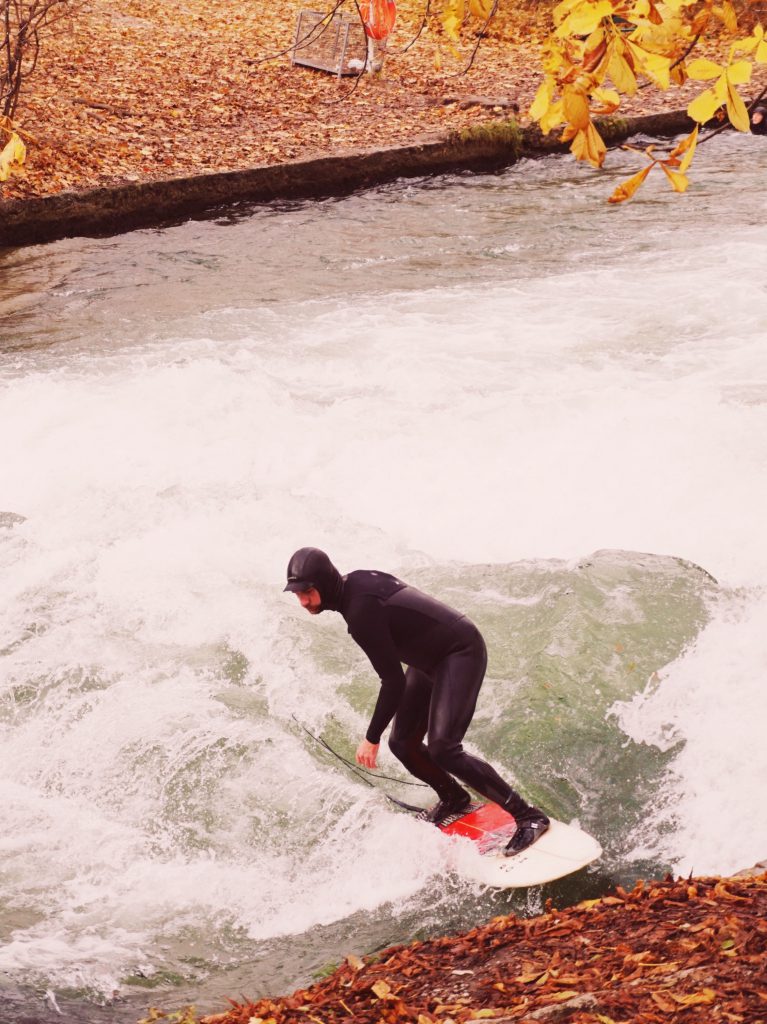

Watch the surfers at the Eisbachwelle
Wait, what, you say? Munich is nowhere near the ocean. Why would you find surfers in winter in Munich, of all places?
Well, yes, all of the above are true…but you will find surfers at the Eisbachwelle, at the entrance of the Englischer Garten park. And watching them is fascinating – even in winter!
The Eisbachwelle is part of a manmade river that flows through the park, and surfers have been riding the break for over 40 years.. A stone step at the outlet of the river creates consistent half-meter tall waves; the surfers have even hacked the waves by adding underwater ropes attached to planks, which create two taller, cleaner U-shaped waves.
I was always curious about the river surfers at Eisbachwelle (my boyfriend is a surfer after all), but I almost didn’t come to see them because I figured…what kind of crazy person would go surfing in the (very cold)?!
LOTS OF THEM, as it turns out. I spotted at least eight surfers here when I visited Eisbachwelle and was absolutely enthralled watching them, as was the crowd of people who were also gathered to watch the surfers. Seriously one of the coolest things to do in Munich in the winter!

Explore the sprawling Englischer Garten park
A sprawling green oasis in the middle of the city, the Englischer Garten (English Garden) stretches from the Munich city center to the northeastern city limits, along the River Isar. It is the largest city park in Munich, and one of the largest urban parks in the entire world.
The Englischer Garten is Munich’s version of New York City’s Central Park or London’s Hyde Park (although bigger!) – you’ll find a network of walking paths, a lake, multiple beer gardens, pavilions, and much more.
The Englischer Garten was commissioned in 1789 by Elector Karl Theodor, who wanted to create a green space for the general public to have an opportunity for leisure and relaxation (as it turns out though, he was not a very popular ruler). The park was originally named Theodors Park, but was changed to Englischer Garten because it was laid out in the style of a traditional English country park.
You’ll find plenty to keep you occupied inside the Englischer Garten, even when in winter in Munich. You can go cross country skiing, go sledding down one of the park’s hills, or even ice skating in the Kleinhesseloher See lake!
One of the park’s highlights is the Chinesischer Turm (Chinese Tower), which actually is not very authentically Chinese, but is still one of Munich’s most recognizable landmarks. It is also where you will find Munich’s oldest and second largest beer garden, and if visiting in December, one of the city’s best Christmas markets.
Further south is the Japanese Garden, which was a gift by the city of Sapporo as a sign of peace and friendship on the occasion of the 1972 Summer Olympic Games, held in Munich. The gardens sit next to an idyllic duck pond, and is also home to an authentic Japanese tea house, which hosts traditional tea ceremonies twice a month.
Another highlight is the Monopteros, a small Greek temple built in 1838 by the famed architect Leo von Klenze. This is one of the most photographed structures in the Englischer Garten – it stands at the top of a small hill, and has a beautiful dome and columns. You’ll also get one of the best views of the Munich skyline from here!


Drink some beer at Hofbräuhaus
Because what better way to warm up than to down a beer (or, erm, a few)? You are visiting the home of Oktoberfest, after all – so obviously, one of the things you need to do is to visit a beer hall.
Perhaps the most famous beer hall in Munich is Hofbräuhaus, which is also one of the oldest in the city. Hofbräuhaus was founded in 1589 by Wilhelm V, the Duke of Bavaria, whose portrait you can find on the beautiful painted ceiling here.
It was originally the brewery for the old royal residence, which once used to stand around the corner. Over the years, Hofbräuhaus has welcomed some very famous patrons, including Mozart.
If you are interested in the history behind this famous pub, I suggest a guided tour – it even comes with a “mass” of beer at the end! You can also take this beer and food culture tour, which includes a tour of Hofbräuhaus, as well as an exclusive tour of the Oktoberfest museum, and tastings of traditional Bavarian food and beer!
Yes, it is touristy AF but it’s so iconic that you just have to have a pint or two at Hofbräuhaus. It’s also a great place to escape the cold!
It’s a super lively atmosphere, with lots of long wooden tables all over the place, which are all first-come, first-serve communal seating. It can get packed here, so you might have to scout the place for a bit before you find an open spot, but be patient and you’ll eventually snag one.
This was kind of awkward for me as a solo traveler – it led to a somewhat embarrassing incident with some older German men because of the language barrier. But in general, everyone is super friendly and I eventually made friends with a group of Singapore Airlines flight attendants who invited me to sit at their table, and ended up having a fun evening!

Feast on some hearty Bavarian food
I don’t know about you, but my favorite thing about traveling by far is sampling all of the local cuisine. And so, at the top of my list of things to do was to stuff myself silly with all the Bavarian food that I could find. And really, what better place to try traditional Bavarian food than in the capital of Bavaria?
Traditional Bavarian food tends to be made up of hearty meats, and potatoes, smothered in some sort of rich gravy. Yes, it is rich and hearty, and can be a bit heavy at times (I was done with it after three straight days of this), but it is definitely the perfect comfort food to eat!
Some of the traditional Bavarian specialties that you need to try:
- Bratwurst (pork sausages) or Weisswurst (white sausages): After all, what is a trip to Germany without eating any sausages?
- Sauerkraut: Finely shredded fermented cabbage, often served as a side dish. Another must-have in Germany.
- Schweinshaxe: Roasted pork knuckle with crispy skin
- Schweinebraten: Traditional Bavarian pork roast, served with a rich gravy
- Weinerschnitzel: Thin pork (or chicken) cutlets that are breaded and fried.
- Spaetzle: Sort of like a German mac n’ cheese.
- Knodels: German potato dumplings. They often come as sides to Scweinbraten and Schweinshaxe and I was OBSESSED with them.

And here are a few of the restaurants I loved in Munich:
- Haxnbauer: This one is famous for its Scweinshaxe and it did not disappoint! The skin was super crispy, while the meat was fall-off-the-bone tender. I could’ve kept eating the accompanying Knodels, they were sooo good! The portions here are HUGE but they have half portions as well – this was more than plenty for me. (Sparkassenstraße 6, 80331 München)
- Augustiner Klosterwirt: One of the best and most authentic Bavarian food restaurants in Munich. The Scweinbraten here is AMAZING – melt-in-your-mouth tender, with some delicious gravy. Wash it all down with some Augustiner beer – Augustiner Klosterwirt stands where the first Augustiner beer was brewed over 700 years ago! (Augustinerstraße 1, 80331 München)
- Andy’s Krablergarten: This popular restaurant is known for its delicious schnitzel – you’ll find several varieties of it here. The meat was tender, but the breaded coating was buttery and all kinds of delicious. It’s also super affordable – a GIANT plate of schnitzel and a beer only set me back €14!

Take a fairytale day trip to Neuschwanstein Castle
Quite possibly the biggest reason that I decided to visit Munich in winter was for the chance to see Neuschwanstein Castle, one of Germany’s most iconic castles. While Neuschwanstein is absolutely stunning at any time of year, it is especially breathtaking when surrounded by a snowy winter wonderland.
Imagine a snow-covered castle nestled on top of an idyllic mountain – it’s close as you can get to a scene straight out of a real-life fairytale. This is the castle that is said to have been the inspiration behind Walt Disney’s Sleeping Beauty castle, and one look at the scene in front of you and it’s easy to see why.
Located 110 kilometers (~68 miles) outside of Munich, a day trip to Neuschwanstein Castle is a must!
The easiest way to get there is to book a guided day tour, which takes care of all the arrangements and transportation for you! You’ll also get to skip the line to buy tickets for and get into the castle (which can sometimes get long) and/or sell out, which allows for a super efficient day trip.
Neuschwanstein Castle is also easily accessible by train. Simply board a train bound for Fussen from the central Hauptbahnhof station. Direct trains leave Munich every two hours, and the trip takes about two hours. You’ll see some stunning scenery of the Bavarian Alps along the way.
I recommend purchasing a Bayern ticket, which allows for unlimited travel on regional trains within the Bavaria region. The cost is €26 for the first passenger. Considering that a one-way ticket to Fussen usually costs almost as much, this is a great deal! If you are traveling to Neuschwanstein Castle as a group, it costs only €8 for each additional passenger (so it costs €34 for 2 people. €42 for 3 people, and so on), which makes the Bayern ticket an even sweeter deal!
Once in Fussen, take the 73 bus (Steingaden / Garmisch-Partenkirchen) or 78 bus (Schwangau), which is impossible to miss because it stops right outside the station and everyone will make a beeline from the train. This will drop you off in Hohenschwangau, the village at the base of the hill leading up to Neuschwanstein Castle.


From Hohenshwangau, you can either hike up the hill (about 30-40 minutes), take a shuttle bus (going up costs €2.50, coming down is €1.50, and a round-trip ticket is €3), or a horse-drawn carriage (€7 to go uphill, and €3.50 to come downhill).
If you wish to see the inside of the castle, be sure to purchase your tickets (or pick up pre-ordered tickets) at the ticket office before you go up the hill towards the castle.
One benefit to visiting Munich in winter is that you’ll find less crowds at Neuschwanstein – tickets often sell out days in advance in the summer. Still, I found a pretty sizable line outside the ticket office, even in the winter, so to ensure that you get tickets for your desired time slot, I suggest you reserve tickets in advance.
Because it had snowed the night before my day trip to Neuschwanstein Castle, the shuttle was not in service. The lines for the horse-drawn carriages looked like it might take hours. So, I ended up walking up the hill – trust me, it wasn’t that bad. Besides, the winter wonderland scenery was absolutely breathtaking and it was cool to see the castle from all different angles as I made my way up.
Since I heard mixed reviews about the inside of Neuschwanstein Castle (many of its rooms were left unfinished), I opted not to do the tour. However, the main draw for me was just to see the castle in person and it absolutely did not disappoint – it looked straight out of a fairytale!
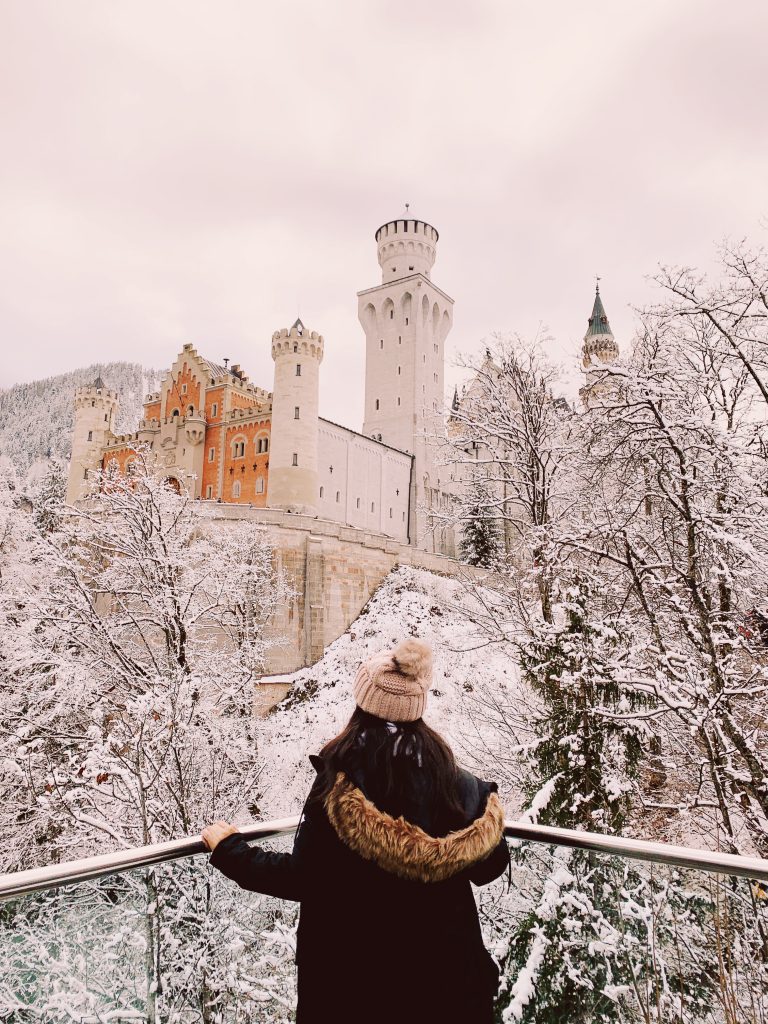
The only caveat to visiting in the winter was that, depending on weather conditions, the Marienbrucke (the main lookout bridge) may be closed because of ice and snow. Unfortunately it was closed on the day of my visit, and not going to lie, I was a bit disappointed. (NOTE: The Marienbrucke bridge is closed until further notice due to extensive restoration work)
However, the tradeoff is that you get to see the castle nestled in the middle of a magical winter wonderland – it was absolutely incredible, and I absolutely think it was worth visiting even though I didn’t get some of the photo ops that I was wanting!
I’ve written more on how to plan a perfect day trip to Neuschwanstein Castle here.
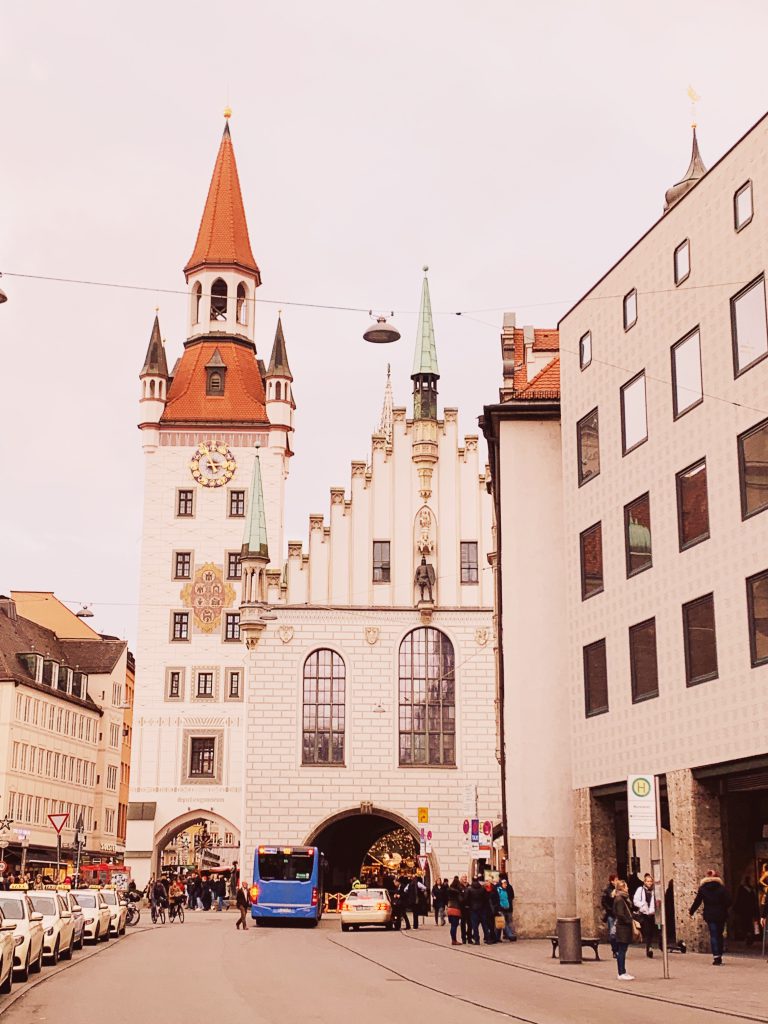
Where to Stay in Munich
Munich has a variety of accommodation options to suit every taste and budget. What neighborhood you should stay in will largely depend on your budget, and what your priorities are.
Here is a brief overview of the best neighborhoods in Munich to stay in:
- Altstadt: The historical center of the city, and where many of Munich’s main attractions are located. This is the best and most convenient area to stay in; however, rates are the highest here.
- Maxvorstadt/Schwabing: Located just north of Altstadt, Maxvorstadt is Munich’s university district and museum quarter. You’ll find lots of galleries and cultural institutions, bookstores, indie boutiques, pubs, and trendy eateries. Also where the Englischer Garten is located.
- Olympiapark: Located just north of Maxvorstadt. You’ll get the best bang for your buck here – you’ll find lots of affordable options here. Altstadt is easily accessible via public transit.
- Glockenbachviertel/Ludwigsvorstadt-Isarvorstadt: Just south of Altstadt, and the trendiest part of Munich. You’ll find plenty of hip bars, trendy boutiques, and restaurants. This area also includes the Hauptbahnhof station, so transportation is also a breeze.


Generally speaking, the closer you are to Altstadt, the better – once you are in Altstadt, you can basically walk to all the major attractions. However, this is the most expensive – staying in one of the outer neighborhoods isn’t a huge deal, since you can easily access the main tourist areas by public transport.
Here are some suggested places to stay in Munich:
- Mercure Olympiapark: This is where I stayed. I’ve stayed at several Mercure properties, and I can always count on them for a comfortable stay – this was no different. The rates were very affordable (under $100/night when I went), and it’s just a 2 minute walk to the tram to take you into Altstadt.
- Cortiina Hotel: This elegant boutique hotel is located just a 5 minute walk from Marienplatz. The rooms are comfortable and modern, with stylish furnishings. The staff is said to be super friendly and helpful as well.
- Hotel Bayerischer Hof: This luxurious boutique hotel is located close to many of Munich’s top attractions. Each of the rooms feature a different design style, from cosmopolitan to colonial. There’s also a rooftop pool, with a stunning view of the city.
Have you been to Munich in winter? What are some of your favorite things about winter in Munich?
You might also like:
One Perfect Day in Munich
Best Christmas Markets in Munich
A Fairytale Munich to Neuschwanstein Castle Winter Day Trip
14 Incredible Things to Do in Prague in Winter
2 Days in Prague: Itinerary + Travel Guide
Like this post? Save these things to do in winter in Munich on Pinterest for later!


Caroline is a Southern California based traveler, writer, and photographer. She travels all around California, the US, and the world in search of the most colorful places, the most delicious food, and bucket-list adventures. Her aim is to inspire other travelers discover how to add more adventure and joy to their lives. On Pictures & Words, you’ll find detailed guides + itineraries, along with vibrant photos to help you plan the the most epic trips. When she’s not traveling, Caroline also runs half marathons.
